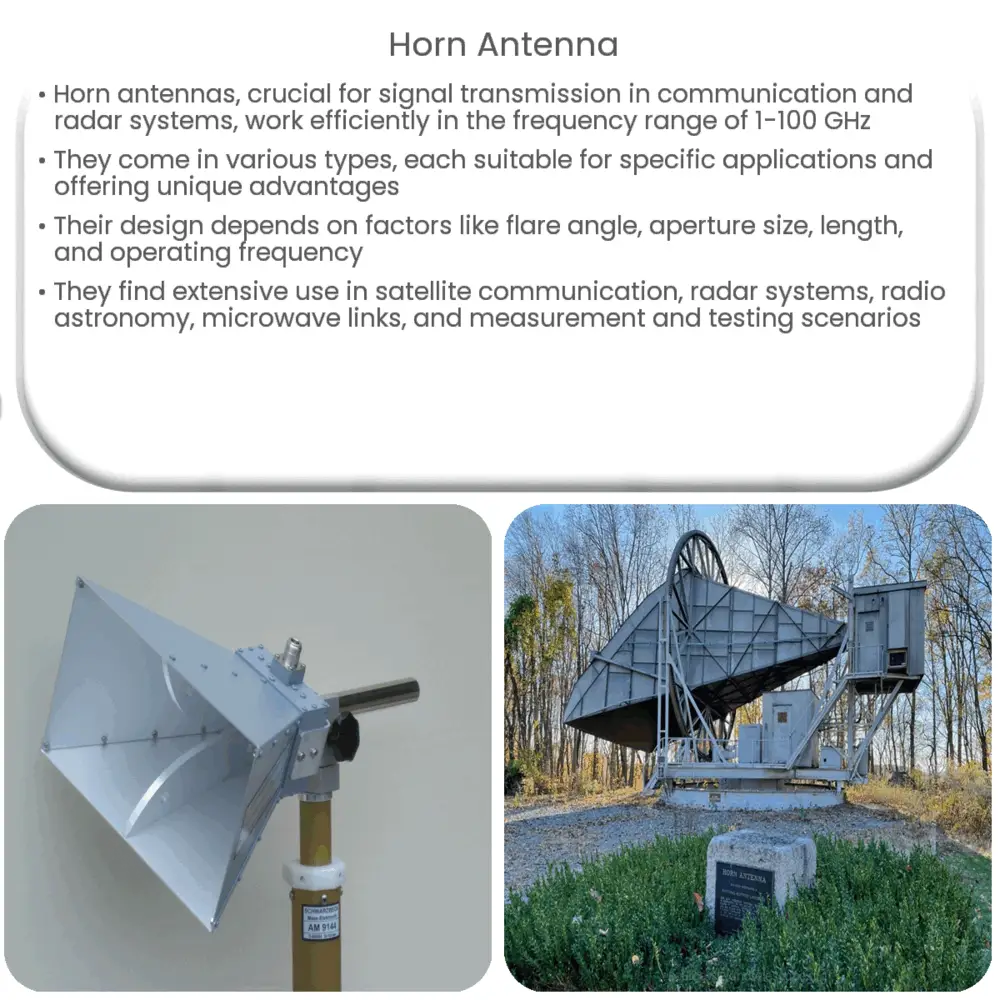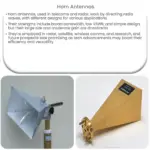Horn antennas are microwave antennas with flared waveguides, offering high directivity and gain, used in radar, communication, and radio astronomy.

Horn Antenna: A Comprehensive Overview
Introduction
The horn antenna is a vital component in various communication and radar systems, playing a crucial role in signal transmission and reception. This article aims to provide a comprehensive overview of the horn antenna, its design, working principle, and applications.
What is a Horn Antenna?
A horn antenna is a microwave antenna that consists of a waveguide whose end is flared out in the form of a horn. The flaring increases the antenna’s directivity and gain, making it an effective radiating element. Horn antennas are particularly useful in the frequency range of 1 GHz to 100 GHz, offering a high degree of directivity and low standing wave ratio (SWR). They are employed in a wide range of applications, including satellite communications, radio astronomy, radar systems, and microwave link systems.
Types of Horn Antennas
There are several types of horn antennas, each with their own advantages and characteristics. Some of the most common types include:
- Pyramidal Horn Antenna: This type of horn antenna features a rectangular waveguide that flares out into a pyramidal shape. Pyramidal horn antennas provide high directivity and gain, making them suitable for various applications, including radar and communication systems.
- Conical Horn Antenna: The conical horn antenna consists of a circular waveguide that expands into a conical shape. These antennas offer a more symmetrical radiation pattern and are commonly used in satellite communication systems and radio astronomy.
- Corrugated Horn Antenna: This design incorporates corrugations or grooves along the inner surface of the horn, improving the antenna’s impedance matching and radiation pattern. Corrugated horn antennas are often used in high-frequency applications, such as radio astronomy and satellite communications.
- Exponential Horn Antenna: Exponential horn antennas, also known as scalar feed horns, have a flare rate that increases exponentially. This results in a smooth radiation pattern with low sidelobe levels, making them ideal for radio astronomy and other applications requiring minimal interference.
Working Principle of Horn Antennas
The primary function of a horn antenna is to convert the guided electromagnetic waves in the waveguide into free-space electromagnetic waves, and vice versa. The horn’s shape serves to direct and focus the radiated energy into a specific direction, increasing the antenna’s directivity and gain.
When a microwave signal is applied to the horn antenna’s input, the waveguide’s electromagnetic fields propagate towards the horn’s flared end. As the waveguide widens, the fields become less confined, and the waves begin to radiate into free space. The horn’s shape and dimensions play a critical role in determining the radiation pattern, gain, and directivity of the antenna.
Conversely, when a horn antenna receives incoming electromagnetic waves, the waves propagate through the horn and are concentrated into the waveguide, where they are guided towards the receiving equipment.
Design Considerations for Horn Antennas
Several factors influence the design and performance of a horn antenna, including the horn’s shape, dimensions, and the operating frequency. Some key design considerations are:
- Flare angle: The flare angle refers to the angle at which the horn’s walls expand. A larger flare angle results in a broader radiation pattern and lower directivity, whereas a smaller flare angle leads to a narrower radiation pattern and higher directivity.
- Aperture size: The aperture size, or the horn’s opening, impacts the antenna’s gain and beamwidth. A larger aperture size increases the gain and narrows the beamwidth, while a smaller aperture size reduces the gain and broadens the beamwidth.
- Length: The length of the horn antenna affects its impedance matching and radiation efficiency. A longer horn provides better impedance matching and higher radiation efficiency, but it also increases the antenna’s size and weight.
- Operating frequency: The operating frequency determines the dimensions of the horn and the waveguide. Higher operating frequencies require smaller waveguide and horn dimensions, whereas lower frequencies necessitate larger dimensions.
Applications of Horn Antennas
Horn antennas are widely used in a variety of applications, including:
- Satellite communication: Horn antennas are frequently used as feed elements for parabolic reflector antennas in satellite communication systems, due to their high directivity and low sidelobe levels.
- Radar systems: Due to their high gain and directivity, horn antennas are employed in radar systems for both transmitting and receiving signals. They are particularly useful in applications requiring precise direction finding and target tracking.
- Radio astronomy: Horn antennas play a significant role in radio astronomy, as they offer a stable and well-defined radiation pattern with minimal sidelobe levels, reducing interference from other sources.
- Microwave link systems: In point-to-point microwave communication links, horn antennas are used to transmit and receive signals over long distances with minimal signal loss.
- Measurement and testing: Horn antennas are commonly used in anechoic chambers and electromagnetic compatibility (EMC) testing facilities for measuring the radiation pattern and gain of other antennas or devices.
Conclusion
Horn antennas are versatile and robust microwave antennas that offer high directivity, gain, and low sidelobe levels. Their various types, such as pyramidal, conical, corrugated, and exponential horn antennas, cater to different applications and requirements. Horn antennas play a vital role in satellite communications, radar systems, radio astronomy, microwave links, and measurement and testing environments. Understanding the design considerations and working principles of horn antennas is crucial for optimizing their performance in different applications.




